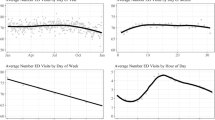Abstract
Introduction
Little is known about the factors driving decision-making among emergency department (ED) providers when prescribing opioid analgesics (OA). The aim of this pilot study was to identify the importance of factors influencing OA-prescribing decisions and to determine how this varied among different types of providers.
Methods
This was an observational cross-sectional survey study of 203 ED providers. The importance of decisional factors was rated on a 5-point Likert scale. Differences between provider groups were tested using Chi-squared or ANOVA tests where applicable.
Results
Overall, 142/203 (69.9 %) potential respondents participated in the study. The five highest-rated factors were (mean ± SD) patient’s opioid prescription history (4.4 ± 0.8), patient’s history of substance abuse or dependence (4.4 ± 0.7), diagnosis thought to be the cause of patient’s pain (4.2 ± 0.8), clinical gestalt (4.2 ± 0.7), and provider’s concern about unsafe use of the medication (4.0 ± 0.9). The importance of 6 of 21 decisional factors varied significantly between different groups of providers.
Conclusion
In this pilot study of ED providers, the self-reported importance of several factors influencing OA-prescribing decisions were significantly different among attending physicians, resident physicians, and advanced practice providers. Further investigation into how ED providers make OA-prescribing decisions is needed to help guide interventions aimed at improving appropriate pain management.
Similar content being viewed by others
References
Chen L-H, Hedegaard H, Warner M. QuickStats: Rates of deaths from drug poisoning and drug poisoning involving opioid analgesics— United States, 1999–2013. MMWR Morb Mortal Wkly Rep [Internet]. 2015;64 Suppl 1:32. Available from: http://www.cdc.gov/mmwr/preview/mmwrhtml/mm6401a10.htm?s_cid=mm6401a10_w. Accessed 15 June 2015.
Paulozzi LJ, Jones CM, Mack KA, Rudd RA. Vital signs: overdoses of prescription opioid pain relievers—United States, 1999–2008. MMWR Morb Mortal Wkly Rep. 2011;60(43):1487–92.
Substance Abuse and Mental Health Services Administration, Center for Behavioral Health Statistics and Quality. The DAWN Report: Highlights of the 2011 Drug Abuse Warning Network (DAWN) Findings on Drug-Related Emergency Department Visits. Rockville, MD. [Internet]. 2013. Available from: http://archive.samhsa.gov/data/2k13/DAWN127/sr127-DAWN-highlights.pdf. Accessed 28 June 2015.
Paulozzi LJ, Mack KA, Hockenberry JM. Division of Unintentional Injury Prevention, National Center for Injury Prevention and Control, CDC. Vital signs: variation among states in prescribing of opioid pain relievers and benzodiazepines—United States, 2012. MMWR Morb Mortal Wkly Rep. 2014;63(26):563–8.
Mazer-Amirshahi M, Mullins PM, Rasooly I, van den Anker J, Pines JM. Rising opioid prescribing in adult U.S. emergency department visits: 2001–2010. Acad Emerg Med. 2014;21(3):236–43.
Rupp T, Delaney KA. Inadequate analgesia in emergency medicine. Ann Emerg Med. 2004;43(4):494–503.
Phillips DM. JCAHO pain management standards are unveiled. Joint commission on accreditation of healthcare organizations. JAMA. 2000;284(4):428–9.
Todd KH, Ducharme J, Choiniere M, Crandall CS, Fosnocht DE, Homel P, et al. Pain in the emergency department: results of the pain and emergency medicine initiative (PEMI) multicenter study. J Pain. 2007;8(6):460–6.
Paulozzi LJ, Budnitz DS, Xi Y. Increasing deaths from opioid analgesics in the United States. Pharmacoepidemiol Drug Saf. 2006;15(9):618–27.
Todd KH. Pain and prescription monitoring programs in the emergency department. Ann Emerg Med. 2010;56(1):24–6.
Cantrill SV, Brown MD, Carlisle RJ, Delaney KA, Hays DP, Nelson LS, et al. Clinical policy: critical issues in the prescribing of opioids for adult patients in the emergency department. Ann Emerg Med. 2012;60(4):499–525.
Washington Emergency Department Opioid Prescribing Guidelines [Internet]. 2011. Available from: http://washingtonacep.org/Postings/edopioidabuseguidelinesfinal.pdf. Accessed 28 June 2015.
New York City Emergency Department Discharge Opioid Prescribing Guidelines [Internet]. 2013. Available from: http://www.nyc.gov/html/doh/downloads/pdf/basas/opioid-prescribing-guidelines.pdf. Accessed 28 June 2015.
Oregon Emergency Department (ED) Opioid Prescribing Guidelines [Internet]. 2012. Available from: http://www.ocep.org/images/pdf/ed_opioid_abuse_guidelines.pdf. Accessed 28 June 2015.
Lembke A. Why doctors prescribe opioids to known opioid abusers. N Engl J Med. 2012;367(17):1580–1.
Bhakta HC, Marco CA. Pain management: association with patient satisfaction among emergency department patients. J Emerg Med. 2014;46(4):456–64.
Poon SJ, Greenwood-Ericksen MB. The opioid prescription epidemic and the role of emergency medicine. Ann Emerg Med. 2014;64(5):490–5.
Motov SM, Marshall JP. Acute pain management curriculum for emergency medicine residency programs. Acad Emerg Med. 2011;18:S87–91.
Tamayo-Sarver JH, Dawson NV, Cydulka RK, Wigton RS, Baker DW. Variability in emergency physician decision making about prescribing opioid analgesics. Ann Emerg Med. 2004;43(4):483–93.
Heins A, Grammas M, Heins JK, Costello MW, Huang K, Mishra S. Determinants of variation in analgesic and opioid prescribing practice in an emergency department. J Opioid Manag. 2006;2(6):335–40.
Burns KEA, Duffett M, Kho ME, Meade MO, Adhikari NKJ, Sinuff T, et al. A guide for the design and conduct of self-administered surveys of clinicians. CMAJ. 2008;179(3):245–52.
Perrone J, DeRoos FJ, Nelson LS. Prescribing practices, knowledge, and use of prescription drug monitoring programs (PDMP) by a national sample of medical toxicologists, 2012. J Med Toxicol. 2012;8(4):341–52.
Mannina L, Varney SM, Bebarta VS, Ganem VJ, Carey KR, Ramos RG. “Hard” and “soft” patient cues that influence ED prescribing for potential opioid misusers. Am J Emerg Med. 2015;33(1):109–11.
Author information
Authors and Affiliations
Corresponding author
Ethics declarations
Conflict of Interest
The authors have no conflicts of interest to report.
Funding Sources
This study is supported in part by the ECIC Faculty Pilot Grant Program from the Emory Center for Injury Control, Emory University; CDC Grant #5R49CE001494
Electronic Supplementary Material
Below is the link to the electronic supplementary material.
ESM 1
(PDF 359 kb)
Rights and permissions
About this article
Cite this article
Pomerleau, A.C., Schrager, J.D. & Morgan, B.W. Pilot Study of the Importance of Factors Affecting Emergency Department Opioid Analgesic Prescribing Decisions. J. Med. Toxicol. 12, 282–288 (2016). https://doi.org/10.1007/s13181-016-0553-9
Received:
Accepted:
Published:
Issue Date:
DOI: https://doi.org/10.1007/s13181-016-0553-9




